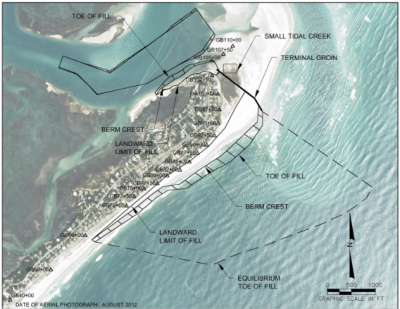FIGURE EIGHT ISLAND – Ballots will soon be mailed to Figure Eight Island property owners to cast their vote for or against a terminal groin at the island’s north end.
The ballots will be distributed concurrently, but separately, from a letter of opposition to the proposed project by 48 property owners representing more than 25 properties on the private island.
Supporter Spotlight
Figure Eight Island Administrator David Kellam said in a Sept. 15 telephone interview the ballots and the letter had yet to be mailed, but will be “some time in the not so distant future.”
“That is the plan,” he said. “They will not be together in the same envelopes, but the intent is to let them both hit the mailbox on the same day.”
Kellam did not give an explanation on why the letters making a case against the terminal groin had not been mailed nearly a week after the homeowners turned in their letter to the Figure Eight Island Homeowners Association’s office.

“The understanding was that we needed to get it to them by September 8,” said Derb Carter, director of the Southern Environmental Law Center’s Chapel Hill office.
A member of Carter’s family owns a home on the island, which is overseen by the five-member association board. Several property owners against the proposed project say, though they’ve been able to voice their opposition in various board meetings over the years, they’ve not been collectively allowed to share that opposition with the other association members until now.
Supporter Spotlight
“The HOA has proposed several alternatives to the (Army Corps of Engineers), but they only talk about one and that is the groin,” Carter said. “Our view is the more information the people have the better the ultimate decision will be.”
Under the Figure Eight Island HOA’s restrictive covenants, only one person per property is allowed to vote.
There are 563 lots on the exclusive island in New Hanover County.
Each property would be assessed a fee to cover the cost of the proposed project, the initial construction of which is an estimated $7.4 million.
Property owners will find out in information provided along with the ballots how much they will be assessed, an amount Kellam declined to discuss.
The 30-year cost of the plan is an estimated $23.5 million, according to the Final Environmental Impact Statement, or FEIS, compiled by a coastal engineering firm hired by the island’s HOA board.

The board’s preferred plan to manage the shoreline at the north end includes a 1,500-foot-long terminal groin – a wall-like structure usually constructed of rock and steel that runs perpendicular to shore – and periodic sand injections on the island’s shores.
Opponents, including environmental groups and some coastal geologists, point out that the north end has accreted, creating acres of unspoiled beach that is habitat crucial to nesting shorebirds. Land north of the terminal groin would vanish, a prediction, opponents point out, is in the FEIS.
Richard Bird owns a home overlooking the sound on the northern end of Figure Eight Island.
“I’ve had this house for 31 years so I’ve watched the north end change over that period of time,” he said. “I think the north end of this island is, by far, the most beautiful part of the island. It’s acres and acres of low, rolling dunes that are vegetated. It’s gorgeous to look at and it’s ideal habitat for nesting shorebirds. The groin would just be very destructive. The area that is now such a good nesting site, that will all be gone.”
Bird, a retired physician, and his wife are among the group of property owners represented in the letter opposing the terminal groin.
The letter urges property owners to support an alternative shoreline erosion control method, one that would maintain the bar channel of Rich Inlet in a position closer to the north end of the island.
The FEIS, released in June, explains that this option would relocate the channel about 1,000 feet to the southwest of its present location. Sand would be dredged every five years to maintain that location. Dredged sand would be placed along 1,400 feet of the Nixon Channel shoreline south of the inlet and pumped onto 12,500 feet of ocean shore from the inlet to Bridge Road.
The 30-year cost of this alternative is more than an estimated $60 million, a figure Bird and other opponents argue is grossly inflated while the cost of the terminal groin is underestimated.

“There are other estimates that are much higher than that,” said Figure Eight Island homeowner Fred Stanback, speaking about the estimated cost of the terminal groin.
Stanback, whose home is in the center of the north end of the island, said he’s been reading up on terminal groins for two decades. He is also named in the letter opposing the structure.
“It’s a big expense and it will be a continuing expense,” he said. “I think it’s just a bad idea, in general, to harden the coast. It’s hard to understand why the board is so determined to go on with this.”
Lawrence Davis, who owns a home on the south end of Figure Eight Island, said he too is puzzled by the board’s preferred alternative, but he is pleased the board agreed to let homeowners opposing the terminal groin share their opinion with the rest of the property owners.
“I’m not aware of any opposition within the board,” Davis said. “The board, they think that since it’s all of one mind, it’s fair to have that view expressed more prominently than other views. I don’t think that gives the membership a balanced picture though to have the information come from one side of the camp. The board has made a gesture of fairness of offering to mail this letter expressing our opposition to this project.”
Every year, for the past five years, the board of directors has presented to property owners the need for a terminal groin, Bird said.
“This is the first time in five years they’ve allowed our side to be heard at all,” he said. “This chairperson we have now has been more fair than anybody we have had recently. This is the first time we’ve had significant, marked contention over something that’s being tried.”
HOA board Chairman Frank Gorham, who also chairs the North Carolina Coastal Resources Commission, did not respond to a request for comment.
A deadline for ballots to be returned has “not been determined yet,” Kellam said. “It’ll likely be somewhere in the neighborhood of 30 to 45 days to return the ballot. That’s our typical practice.”
If a majority of the membership votes in favor of a terminal groin, the board’s next likely step will be to apply for a North Carolina Coastal Area Management Act, or CAMA, major permit. That is, if the board is able to get the property easements needed to build the terminal groin, a task some property owners predict the board will not be able to accomplish.
Figure Eight Island is unincorporated, which means the board doesn’t have government authority to take land easements through condemnation.
“We know of at least three (property owners) and probably maybe even more that have said absolutely not, they’re not going to give an easement,” Bird said.
According to state statute, a CAMA major permit application must include a copy of the deed “or other instrument” claiming title to the property.
“We’re continually moving along with easements and we’re in discussions with individuals pertaining to that,” Kellam said.
Ballots and copies of the property owners’ letter will be mailed to a property owner’s address of record.







